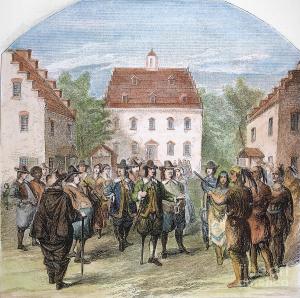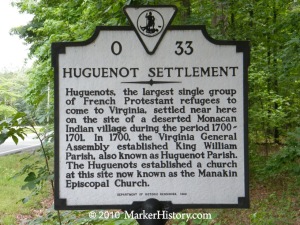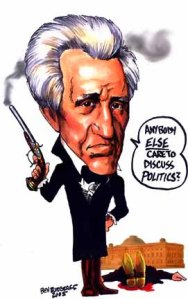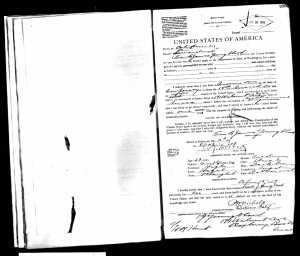
Artist is Granger, New Amsterdam, 1660. Governor Peter Stuyvesant and Dutch Settlers in New Amsterdam parlaying with Indians. Wood engraving, 1855.http://render.fineartamerica.com/displayartwork.html?id=4060758&width=249&height=248&domainid=1
Magdaleen Helena Van Swol was my/our 8th great-grandmother, and the grandmother of almost everyone in my Youngblood facebook group which numbers about 40 people. Obviously, she has a lot more descendants than that, but considering she lived from 1630-1697, to think that almost 400 years later, 40 of her descendants have gathered together to get to know each other and to research family history, is more than amazing! Can you imagine what she would have thought had she dreamed her descendants were thinking of her, looking into her life, in 2014! Our lives, our homes, our machines, would have amazed her to say the least.
We don’t know a lot about her early life, but she was born in New Amsterdam, New York in 1630. Think about that, Plymouth was settled in 1620, and here is our ancestor born in New York in 1630! Hard to believe. Unfortunately, we do not even know her mother’s name, and we know her father, Hans Van Swol, died in 1633. So where was she from age 3 to age 22 when she married our 8th great- grandfather, Hendrick Jansen Spier, birth 1619 in Aschwaerde, Stift, Bremen, Germany, death 12 May 1679 in Pemperpogh, Bergen, New Jersey, United States? For now, that remains a mystery.

Museum of the City of New York – Peter Stuyvesant, the fourth and most famous of the Dutch Governor – Generals was appointed in 1647. It was his lot to be obliged to surrender New Netherland to the English in 1664. collections.mcny.org
If you are interested in some overall history of the settlement by the Dutch of New Amsterdam, this article in Wikipedia provides a good overview, some of which is reproduced for you here:
: “New Amsterdam (Dutch: Nieuw-Amsterdam) was a 17th-century Dutch settlement established at the southern tip ofManhattan Island, which served as the seat of the colonial government in New Netherland territory. It was renamed New York on September 8, 1664, in honor of the then Duke of York (later James II of England) after English forces seized control of Manhattan Island, along with the rest of the Dutch colony.
The settlement, outside of Fort Amsterdam on Manhattan Island, in the New Netherland (1614–1664), was a provincial extension of the Dutch Republic as of 1624. Situated on the strategic, fortifiable southern tip of the island of Manhattan, the fort was meant to defend the Dutch West India Company‘s fur trade operations in the North River (Hudson River). Fort Amsterdam was designated the capital of the province in 1625.
The 1625 date of the founding of New Amsterdam is now commemorated in the official Seal of New York City. (Formerly, the year on the seal was 1664, the year of the provisional Articles of Transfer, assuring New Netherlanders that they “shall keep and enjoy the liberty of their consciences in religion”, negotiated with the English by Pieter Stuyvesant and his council.)”
“The first recorded exploration by the Dutch of the area around what is now called New York Bay was in 1609 with the voyage of the ship Halve Maen (English: “Half Moon”), captained by Henry Hudson[2] in the service of the Dutch Republic, as the emissary of Maurice of Nassau, Prince of Orange, Holland’s stadholder. Hudson named the river the Mauritius River. He was covertly attempting to find the Northwest Passage for the Dutch East India Company. Instead, he brought back news about the possibility of exploitation of beaver pelts in the area, leading to private commercial interest by the Dutch who sent commercial, private missions to the area the following years.
At the time, beaver pelts were highly prized in Europe, because the fur could be felted to make waterproof hats. A by-product of the trade in beaver pelts was castoreum—the secretion of the animals’ anal glands—which was used for its medicinal properties and for perfumes. The expeditions by Adriaen Block and Hendrick Christiansz in 1611, 1612, 1613 and 1614 resulted in the surveying and charting of the region from the 38th parallel to the 45th parallel. On their 1614 map, which gave them a four-year trade monopoly under a patent of the States General, they named the newly discovered and mapped territory New Netherland for the first time. It also showed the first year-round trading presence in New Netherland, Fort Nassau, which would be replaced in 1624 by Fort Orange, which eventually grew into the town of Beverwyck, now Albany.
Dominican trader Juan Rodriguez (rendered in Dutch as Jan Rodrigues), born in Santo Domingo of Portuguese and African descent, arrived in Manhattan during the winter of 1613–1614, trapping for pelts and trading with the local population as a representative of the Dutch. He was the first recorded non-Native Americaninhabitant of what would eventually become New York City.[3][4]
The territory of New Netherland, containing the Northeast’s largest rivers with access to the beaver trade, was originally a private, profit-making commercial enterprise focusing on cementing alliances and conducting trade with the diverse Indian tribes. Surveying and exploration of the region was conducted as a prelude to an anticipated official settlement by the Dutch Republic, which occurred in 1624.
In 1620 the Pilgrims attempted to sail to the Hudson River from England. However, the Mayflower reached Cape Cod(now part of Massachusetts) on November 9, 1620, after a voyage of 64 days.[5] For a variety of reasons, primarily a shortage of supplies, the Mayflower could not proceed to the Hudson River and the colonists decided to settle somewhere on or near Cape Cod.[5]
The mouth of the Hudson River was selected as the ideal place for initial settlement as it had easy access to the ocean while also securing an ice-free lifeline to the beaver trading post near present day Albany, settled in 1614. Here American Indian hunters supplied them with pelts in exchange for European-made trade goods and wampum, which was soon being made by the Dutch on Long Island. In 1621 the Dutch West India Company was founded. Between 1621 and 1623, orders were given to the private, commercial traders to vacate the territory, thus opening up the territory to Dutch settlers and company traders. It also allowed the laws and ordinances of the states of Holland to apply. Previously, during the private, commercial period, only the law of the ship had applied.
In 1624 the first group of families arrived on Noten Eylant (Nut Island, now Governors Island) to take possession of the New Netherland territory and to operate various trading posts. They were spread out to Verhulsten Island (Burlington Island) in the South River (now the Delaware River), to Kievitshoek (now Old Saybrook, Connecticut) at the mouth of the Verse River (now the Connecticut River) and further north on the Mauritius or North River (now the Hudson River), near what is now Albany.
Upon first settlement on Noten Eylant in 1624, a fort and sawmill were built. The latter was constructed by Franchoys Fezard.
The New Amsterdam settlement had a population of approximately 270 people, including infants. In 1642 the new director-general Willem Kieft decided to build a stone church within the fort. The work was carried out by recent English immigrants, the brothers John and Richard Ogden. The church was finished in 1645 and stood until destroyed in the Slave Insurrection of 1741.
On August 27, 1664, while England and the Dutch Republic were at peace, four English frigates sailed into New Amsterdam’s harbor and demanded New Netherland’s surrender, whereupon New Netherland was provisionally ceded by director-general Peter Stuyvesant. On September 6 Stuyvesant sent lawyer Johannes De Decker and five other delegates to sign the official Articles of Capitulation. This was swiftly followed by the Second Anglo-Dutch War, between England and the Dutch Republic. In June 1665, New Amsterdam was reincorporated under English law as New York City, named after the Duke of York (later King James II). He was the brother of the English King Charles II, who had been granted the lands.[11]”
Hopefully, further research will lead us to discover more about her childhood. However, she has an interesting adulthood for us to consider. She married our grandfather Hendrick Spier in 1652, and had her first of nine children in 1653, a son, Johannes Jan Spier, 1653-1724. Johannes becomes our 7th great grandfather. The others included:
- Tryntje SPIER, 1654 – 1657
- Seytje Spier, 1655 –
- Jacobus Spier, 1659 – 1670
- Hans Hendrickszen Spier, 1663 – 1726
- Willemtje Spier, 1665 –
- Cathryntje SPIER, 1667 –
- Abraham Spier, 1671 – 1679
- Barent Spier, 1675 – 1742
Notice that Abraham Spier died at age 8. We can see that he was buried at the Bergen Protestant Reformed Church, in Bergen, New Jersey. So the family had certainly moved from New Amsterdam to New Jersey by then. The record below is from the Holland Society, documenting records concerning Magdaleen Hans Spier, in the Bergen Records of the Reformed Protestant Dutch Church. Notice, she lost her husband and her child the same year! Abraham, May 12, and Hendrick on June 12, wonder if they were connected?
Their last child was born in 1675, and then, not Magdaleen, but Hendrick Jansen Spier her husband dies in 1679. She has at least four, maybe five children still at home. Maybe that is why she remarried immediately, to keep her children well taken care of. She married Harmen Edwards at her age 49, in 1679. Unfortunately, he died in 1681, when her youngest was only 6 years old, and Catheryn was just 14, and William 16. She married for a third time again immediately. This time she married a wealthy man, Jan Aertsen Van der Bilt. Even though she would have been 54 years old, we are told she and Jan Van der Bilt had one child together, Jan Janse Van Der Bilt, 1684-1737. He is our 7th great Uncle, just like all of Magdaleen’s children, but he gives us entry into the wealthy Vanderbilt family! That alone is a noteworthy event, but one that always makes me stop and ponder my very middle class existence!
We can see that Jan Vanderbilt was active in his stepchildren’s lives, and even their children, his stepchildren, in this article from these sources: “Bergen, T., “Early Settlers, Kings Co., Long Island, New York”, pp 319-321; Boyer, C., “Ancestral Lines,” p 230; Strong, T. M., “History of Flatbush,” p 60; Kip, F. E., “Kip Family,” p 89; Hoppin, C. A., “Washington Ancestry,” v. 3, p 64, Genealogical Magazine of New Jersey, v 55, pp 1-3; Collections, Holland Society,” Records Dutch Reformed Church, Bergen, New Jersey, V 4.)
Jan Aertsen Vanderbilt (b. 1627, d. 02 Feb 1704/05)
Jan Aertsen Vanderbilt was born 1627 in Holland, and died 02 Feb 1704/05 in Bergen,(Jersey City),NJ. He married Anneken Hendricks on 06 Feb 1649/50 in DRC New Amsterdam,New Netherlands.
Notes for Jan Aertsen Vanderbilt:
Jan Aertsen Vanderbilt was born about 1627 in Holland. Jean M. Rand, in her book “Some Descendants of Jan Aertsen Vanderbilt” speculates that Jan’s father was named Aert (because of the use of patronymics by the Dutch). She also speculates that he came from Bilt, 3 miles east of Utrecht, Holland. He was about 13 when he emigrated to New Amsterdam. He was indentured, 12 Oct 1640, to Peter Wholfertsen Van Couvenhoven for three years. At age 16, in 1643, he participated in Indian fighting in the area. Jan had no money, this is why he was indentured as a servant for three years. Jan was very industrious, he was a prosperous farmer and owned land in a variety of places. Dorothy Kelly MacDowell in her book “Commodore Vanderbilt and His Family” places Jan Aertsen’s birth date at about 1620. Since he died in 1705, his age would be between 78 and 85.
Jan married his first wife at the Dutch Reformed Church at New Amsterdam on February 6, 1650 to Anneken Hendricks. Jan was about 23. Jan and Anneken had three children. Anneken died about 1655. Jan was 28.
Jan married his second wife between 1655 and 1660. Jan was between 28 and 33. She was Dieber (Divertje) Cornelis, the widow of Lubbert Gysbertsen. Jan become the stepfather of five children. Jan and Dieber had one child. Dieber died before 1680.
Jan Aertsen owned a farm in 1661the location of which was described in the “The Social History of Flatbush” by Gertrude Lefferts Vanderbilt, published in 1881, in pages 221 and 229 as “From the south corner of Clarkson Street to the South corner of Winthrop Street… The original farm is now enclosed within Prospect Park.”
Jan lived in New Amsterdam in 1663. On February 5, 1667, Jan mortgaged a bouwery of his in Flushing, Queens, New York, to Nicholas de Meyer
Jan married his third wife on December 10, 1681 in Flatbush, Brooklyn, New York. Jan was 54. She was Magdalena Hanse/Jans Van Swol, the widow of Hendrick Jansen Spier and Harmen Edwards. Jan became the stepfather of nine more children. Jan and Magdalena had one child.
Jan Aertsen Vanderbilt had joined the Bergen, NJ Dutch Reformed Church by 1682. He sponsered the baptism of Frans Spier, his step grandchild, born 2 April 1683, and of Hendrick Spier, his step grandchild, born in 1685. Jan was on the Rate List of Flatbush in 1683. In the same year he and his son Aris Janse were named Overseers. Jan owned land in Bergen New Jersey in 1694. Jan died there in 1705 at age 78. –this article was originally shared on Ancestry’s website by W. _VanCleave originally shared this to Van Cleave Family
Magdaleen Van Swol, my/our 8th great grandmother, was a courageous pioneer, a mother of ten, and took us through the Spear family as well as connecting us to the Vanderbilts! What an interesting woman she was, and what an interesting surname to add to our collection of names. Magadaleen enriches our Dutch ancestry as well.
Magdaleen Hans VanSwol (1630 – 1697)
is your 8th great grandmother
Johannes Jan Spier (1653 – 1724)
son of Magdaleen Hans VanSwol
Frans Johannisse Spier (1683 – 1771)
son of Johannes Jan Spier
son of Frans Johannisse Spier
Hendrick Jansen Spier (1760 – 1850)
son of Jacobus Spier
son of Hendrick Jansen Spier
son of Jacob Speer
daughter of Edwin Speer
Edwin Spear Youngblood (1882 – 1943)
son of Clara B. Spear
Cecil Hogue Youngblood (1910 – 1988)
son of Edwin Spear Youngblood
You are the daughter of Cecil Hogue Youngblood – (























































































